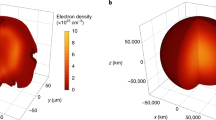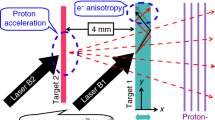Abstract
KENTY1 noticed, many years ago, the finite lapse of time occurring between the termination of current flow in a low-pressure discharge in argon and the occurrence of maximum visible intensity of the afterglow. He suggested that the latter was due largely to radiative electron-ion recombination, and that the time-lapse was necessary for the electron temperature to fall to a value comparable with the gas temperature when the afterglow intensity would have reached a maximum, since recombination would continually reduce the electron and ion density. Bayet2 and others have noticed a similar phenomenon and attribute it to the same cause. Also, an analogous effect due to pickup, in the afterglow, of electron energy from a microwave beam has been elegantly demonstrated by Goldstein and his collaborators3.
This is a preview of subscription content, access via your institution
Access options
Subscribe to this journal
Receive 51 print issues and online access
$199.00 per year
only $3.90 per issue
Buy this article
- Purchase on Springer Link
- Instant access to full article PDF
Prices may be subject to local taxes which are calculated during checkout
Similar content being viewed by others
References
Kenty, C., Phys. Rev., 32, 624 (1928).
Bayet, M., Rev. Sci. (Paris), 89, 351 (1951).
Goldstein, L., Anderson, J. M., and Clark, G. L., Phys. Rev., 90, 486 (1953).
Biondi, M. A., Phys. Rev., 82, 453 (1951).
Massey, H. S. W., “Advances in Physics”, 1, 395 (1952).
Olsen, H. L., and Huxford, W. S., Phys. Rev., 87, 922 (1952).
Mohler, F. L., Bur. of Stand. J. of Res., 19, 447 (1937).
Massey, H. S. W., and Burhop, E. H. S., “Electronic and Ionic Impact Phenomena” (Oxford, 1952).
Author information
Authors and Affiliations
Rights and permissions
About this article
Cite this article
CRAIG, R., CRAGGS, J. Non-isothermal Plasmas in the Rare Gases. Nature 174, 367–368 (1954). https://doi.org/10.1038/174367b0
Issue Date:
DOI: https://doi.org/10.1038/174367b0
Comments
By submitting a comment you agree to abide by our Terms and Community Guidelines. If you find something abusive or that does not comply with our terms or guidelines please flag it as inappropriate.



